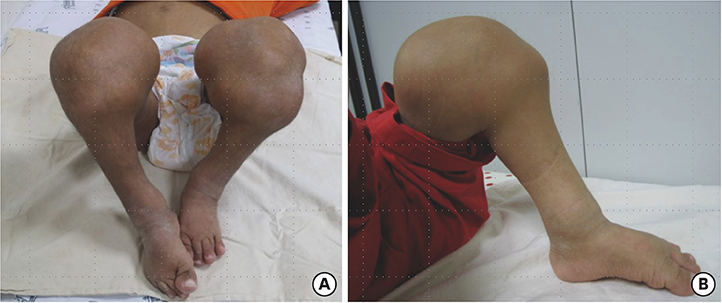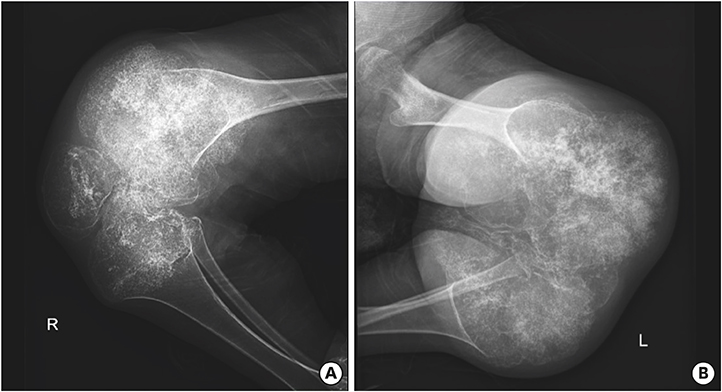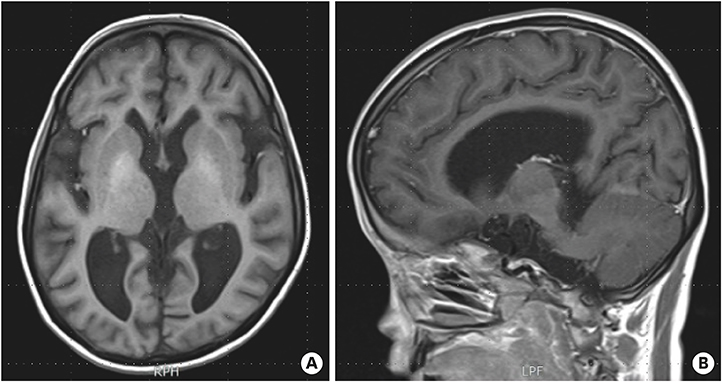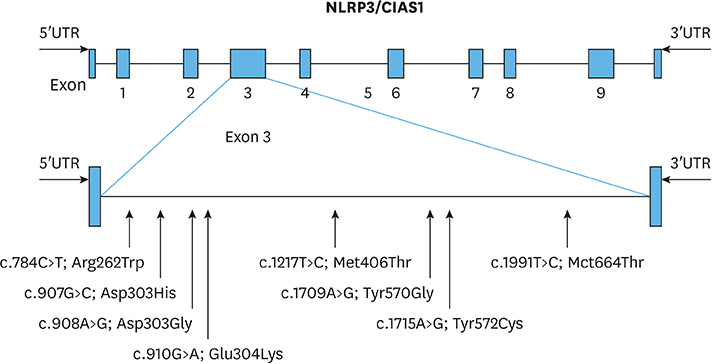Pediatr Infect Vaccine.
2018 Dec;25(3):113-122. 10.14776/piv.2018.25.e7.
The First Report on Clinical Manifestation of Cryopyrin-Associated Periodic Syndrome in Korean Children
- Affiliations
-
- 1Department of Pediatrics, Seoul National University College of Medicine, Seoul, the Republic of Korea. jgkim@snu.ac.kr
- 2Department of Pediatrics, Kangwon National University Hospital, Chuncheon, the Republic of Korea.
- 3Department of Pediatrics, Pusan National University Yangsan Hospital, Yangsan, the Republic of Korea.
- 4Department of Pediatrics, Asan Medical Center, University of Ulsan College of Medicine, Seoul, the Republic of Korea.
- 5Department of Pediatrics, Seoul National University Bundang Hospital, Seongnam, the Republic of Korea.
- KMID: 2428248
- DOI: http://doi.org/10.14776/piv.2018.25.e7
Abstract
- PURPOSE
The aim of this study was to evaluate the clinical characteristics of children diagnosed as cryopyrin-associated periodic syndrome (CAPS) in Korea.
METHODS
Diagnosis was made based on clinical features and confirmed by a mutation in the cold-induced autoinflammatory syndrome 1 (CIAS1) gene. Especially, osteocartilaginous overgrowth in the patella or distal femur was so characteristic that its presence warranted a diagnosis of chronic infantile neurologic cutaneous and articular/NOMID.
RESULTS
We observed the clinical features of 9 Korean CAPS patients. All the patients suffered from an urticarial rash with recurrent fever. Among the 9 patients, 6 presented with rash and 4 with fever on the 1st or 2nd days of birth. Eight patients showed myalgia, and 7 patients showed arthralgia in the joints, and 6 patients showed radiologic findings of arthropathy including cupping of the metaphysis, excessive growth of the epiphysis, osteopenia or overgrowth of the cartilage. Four patients showed brain atrophy, enlarged ventricles or leptomeningeal enhancement on magnetic resonance imaging. Intellectual disability was observed in 1 patient. Five patients had eye involvement as conjunctivitis, uveitis, chorioretinitis, avascular area or papillary edema, and 3 patients showed progressive hearing loss. All 9 patients showed increased C-reactive protein (CRP) and erythrocyte sedimentation rate (ESR).
CONCLUSIONS
All the patients carried a mutation on exon 3 of the CIAS1 gene. After the anakinra (interleukin-1 receptor antagonist) therapy, the fever and rash immediately disappeared, and CRP and ESR were improved.
Keyword
MeSH Terms
-
Arthralgia
Atrophy
Blood Sedimentation
Bone Diseases, Metabolic
Brain
C-Reactive Protein
Cartilage
Child*
Chorioretinitis
Conjunctivitis
Cryopyrin-Associated Periodic Syndromes*
Diagnosis
Edema
Epiphyses
Exanthema
Exons
Femur
Fever
Hearing Loss
Humans
Intellectual Disability
Interleukin 1 Receptor Antagonist Protein
Joints
Korea
Magnetic Resonance Imaging
Myalgia
Parturition
Patella
Uveitis
C-Reactive Protein
Interleukin 1 Receptor Antagonist Protein
Figure
Reference
-
1. Levy R, Gérard L, Kuemmerle-Deschner J, Lachmann HJ, Koné-Paut I, Cantarini L, et al. Phenotypic and genotypic characteristics of cryopyrin-associated periodic syndrome: a series of 136 patients from the Eurofever registry. Ann Rheum Dis. 2015; 74:2043–2049.
Article2. Kuemmerle-Deschner JB. CAPS--pathogenesis, presentation and treatment of an autoinflammatory disease. Semin Immunopathol. 2015; 37:377–385.
Article3. Yu JR, Leslie KS. Cryopyrin-associated periodic syndrome: an update on diagnosis and treatment response. Curr Allergy Asthma Rep. 2011; 11:12–20.
Article4. Schroder K, Zhou R, Tschopp J. The NLRP3 inflammasome: a sensor for metabolic danger? Science. 2010; 327:296–300.
Article5. Tanaka N, Izawa K, Saito MK, Sakuma M, Oshima K, Ohara O, et al. High incidence of NLRP3 somatic mosaicism in patients with chronic infantile neurologic, cutaneous, articular syndrome: results of an international multicenter collaborative study. Arthritis Rheum. 2011; 63:3625–3632.
Article6. Aksentijevich I, Nowak M, Mallah M, Chae JJ, Watford WT, Hofmann SR, et al. De novo CIAS1 mutations, cytokine activation, and evidence for genetic heterogeneity in patients with neonatal-onset multisystem inflammatory disease (NOMID): a new member of the expanding family of pyrin-associated autoinflammatory diseases. Arthritis Rheum. 2002; 46:3340–3348.
Article7. Hoffman HM, Mueller JL, Broide DH, Wanderer AA, Kolodner RD. Mutation of a new gene encoding a putative pyrin-like protein causes familial cold autoinflammatory syndrome and Muckle-Wells syndrome. Nat Genet. 2001; 29:301–305.
Article8. Milhavet F, Cuisset L, Hoffman HM, Slim R, El-Shanti H, Aksentijevich I, et al. The infevers autoinflammatory mutation online registry: update with new genes and functions. Hum Mutat. 2008; 29:803–808.
Article9. Feldmann J, Prieur AM, Quartier P, Berquin P, Certain S, Cortis E, et al. Chronic infantile neurological cutaneous and articular syndrome is caused by mutations in CIAS1, a gene highly expressed in polymorphonuclear cells and chondrocytes. Am J Hum Genet. 2002; 71:198–203.
Article10. Mehr S, Allen R, Boros C, Adib N, Kakakios A, Turner PJ, et al. Cryopyrin-associated periodic syndrome in Australian children and adults: epidemiological, clinical and treatment characteristics. J Paediatr Child Health. 2016; 52:889–895.
Article11. Kuemmerle-Deschner JB, Ozen S, Tyrrell PN, Kone-Paut I, Goldbach-Mansky R, Lachmann H, et al. Diagnostic criteria for cryopyrin-associated periodic syndrome (CAPS). Ann Rheum Dis. 2017; 76:942–947.
Article12. Aróstegui JI, Aldea A, Modesto C, Rua MJ, Argüelles F, González-Enseñat MA, et al. Clinical and genetic heterogeneity among Spanish patients with recurrent autoinflammatory syndromes associated with the CIAS1/PYPAF1/NALP3 gene. Arthritis Rheum. 2004; 50:4045–4050.
Article13. Hoffman HM, Wanderer AA, Broide DH. Familial cold autoinflammatory syndrome: phenotype and genotype of an autosomal dominant periodic fever. J Allergy Clin Immunol. 2001; 108:615–620.
Article14. Lachmann HJ, Kone-Paut I, Kuemmerle-Deschner JB, Leslie KS, Hachulla E, Quartier P, et al. Use of canakinumab in the cryopyrin-associated periodic syndrome. N Engl J Med. 2009; 360:2416–2425.
Article15. Miyamae T. Cryopyrin-associated periodic syndromes: diagnosis and management. Paediatr Drugs. 2012; 14:109–117.16. Kolivras A, Theunis A, Ferster A, Lipsker D, Sass U, Dussart A, et al. Cryopyrin-associated periodic syndrome: an autoinflammatory disease manifested as neutrophilic urticarial dermatosis with additional perieccrine involvement. J Cutan Pathol. 2011; 38:202–208.
Article17. Kitley JL, Lachmann HJ, Pinto A, Ginsberg L. Neurologic manifestations of the cryopyrin-associated periodic syndrome. Neurology. 2010; 74:1267–1270.
Article18. Perini F, D'Andrea G, Galloni E, Pignatelli F, Billo G, Alba S, et al. Plasma cytokine levels in migraineurs and controls. Headache. 2005; 45:926–931.
Article19. Goldbach-Mansky R, Dailey NJ, Canna SW, Gelabert A, Jones J, Rubin BI, et al. Neonatal-onset multisystem inflammatory disease responsive to interleukin-1beta inhibition. N Engl J Med. 2006; 355:581–592.
Article20. Aksentijevich I, Putnam CD, Remmers EF, Mueller JL, Le J, Kolodner RD, et al. The clinical continuum of cryopyrinopathies: novel CIAS1 mutations in north American patients and a new cryopyrin model. Arthritis Rheum. 2007; 56:1273–1285.
Article21. Prieur AM, Griscelli C, Lampert F, Truckenbrodt H, Guggenheim MA, Lovell DJ, et al. A chronic, infantile, neurological, cutaneous and articular (CINCA) syndrome. A specific entity analysed in 30 patients. Scand J Rheumatol Suppl. 1987; 66:57–68.
Article22. Hill SC, Namde M, Dwyer A, Poznanski A, Canna S, Goldbach-Mansky R. Arthropathy of neonatal onset multisystem inflammatory disease (NOMID/CINCA). Pediatr Radiol. 2007; 37:145–152.
Article23. Saito M, Nishikomori R, Kambe N, Fujisawa A, Tanizaki H, Takeichi K, et al. Disease-associated CIAS1 mutations induce monocyte death, revealing low-level mosaicism in mutation-negative cryopyrin-associated periodic syndrome patients. Blood. 2008; 111:2132–2141.
Article24. Cuisset L, Jeru I, Dumont B, Fabre A, Cochet E, Le Bozec J, et al. Mutations in the autoinflammatory cryopyrin-associated periodic syndrome gene: epidemiological study and lessons from eight years of genetic analysis in France. Ann Rheum Dis. 2011; 70:495–499.
Article25. Dodé C, Le Dû N, Cuisset L, Letourneur F, Berthelot JM, Vaudour G, et al. New mutations of CIAS1 that are responsible for Muckle-Wells syndrome and familial cold urticaria: a novel mutation underlies both syndromes. Am J Hum Genet. 2002; 70:1498–1506.
Article26. Neven B, Callebaut I, Prieur AM, Feldmann J, Bodemer C, Lepore L, et al. Molecular basis of the spectral expression of CIAS1 mutations associated with phagocytic cell-mediated autoinflammatory disorders CINCA/NOMID, MWS, and FCU. Blood. 2004; 103:2809–2815.
Article27. Caroli F, Pontillo A, D'Osualdo A, Travan L, Ceccherini I, Crovella S, et al. Clinical and genetic characterization of Italian patients affected by CINCA syndrome. Rheumatology (Oxford). 2007; 46:473–478.
Article28. Muckle TJ. The ‘Muckle-Wells’ syndrome. Br J Dermatol. 1979; 100:87–92.
Article29. Jaeger VK, Hoffman HM, van der Poll T, Tilson H, Seibert J, Speziale A, et al. Safety of vaccinations in patients with cryopyrin-associated periodic syndromes: a prospective registry based study. Rheumatology (Oxford). 2017; 56:1484–1491.
Article
- Full Text Links
- Actions
-
Cited
- CITED
-
- Close
- Share
- Similar articles
-
- The First Case Series of Cryopyrin-Associated Periodic Syndrome in Korea
- A Case of Primary Sjorgen's Syndrome Presenting as Hypokalemic Periodic Paralysis
- A case of PFAPA (periodic fever, aphthous stomatitis, pharyngitis, cervical adenitis) syndrome
- Dental Treatment in a Patient with CINCA Syndrome under General Anesthesia
- A Case Report of Glomus Tumor of the Nasal Columella





